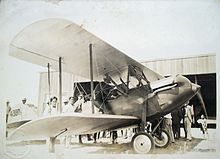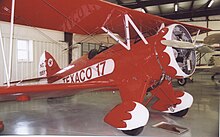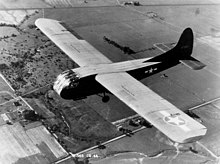Waco Aircraft Company
| Formerly | Weaver Aircraft Company |
|---|---|
| Industry | Aerospace |
| Founded | 1920 |
| Defunct | 1947 |
| Headquarters | , United States |


The Waco Aircraft Company (WACO) was an aircraft manufacturer located in Troy, Ohio, United States. Between 1920 and 1947, the company produced a wide range of civilian biplanes.
The company initially started under the name Weaver Aircraft Company of Ohio but changed its name to the Waco Aircraft Company in 1928/29.
Company name
WACO (referring to the aircraft) is usually pronounced "wah-co"[1] (the first syllable pronounced as in "water"), not "way-co" like Waco, Texas, whose name is entirely unrelated.
Several companies operated under the Waco name, with the first company being the Weaver Aircraft Company, a firm founded by George E. Weaver, Clayton Bruckner, and Elwood Junkin in 1920 in Lorain and Medina, Ohio after they had already been collaborating for several years. In the spring of 1923 this became the Advance Aircraft Company in Troy, Ohio, after the departure of Weaver.
In 1929, it was changed from Advance Aircraft Company to Waco Aircraft Company.
History
Origins and early success
Waco's history started in 1919 when businessmen Clayton J. "Clayt" Brukner and Elwood "Sam" Junkin met barnstorming pilots Charles "Charley" William Meyers and George "Buck" Weaver. Although their initial floatplane design was a failure, they went on to found the Waco company in 1920 and established themselves as producers of reliable, rugged planes that were popular with travelling businessmen, postal services and explorers, especially after the company began producing closed-cabin biplane models after 1930 in addition to the open cockpit biplanes.[3]
The Waco name was extremely well represented in the U.S. civil aircraft registry between the wars, with more Wacos registered than the aircraft of any other company. Production types including open cockpit biplanes, cabin biplanes and cabin sesquiplanes (known by Waco as Custom Cabins) as well as numerous experimental types.[citation needed]
World War II
During
End of normal operations
Waco ceased operations in 1947,[4] having suffered the fate of a number of general aviation companies when an anticipated boom in aviation following World War II failed to develop.[5] The final Waco relied on an experimental Franklin engine which, with the cancellation of other contracts became so expensive, the Aristocraft, which relied on it, was cancelled.[6]
Revivals
Modern European WACOs
The Waco brand name was briefly revived, in the 1960s and early 1970s—for a scheme to produce, assemble, re-assemble or market a series of modern, all-metal Italian and French lightplanes (
- WACO Sirrus – a relabeled Italian SIAI Marchetti S.205 comparable to the Piper PA-28 Cherokee line, a four-seat touring airplane offered with fixed or retractable gear, and Franklin or Lycoming engines ranging from 180 to 220 horsepower.[8][9][11]
- WACO Vela – the Italian
- WACO Meteor – a relabeled Italian
- WACO Minerva – relabeled French
Modern production
The WACO Classic Aircraft company (unrelated to the original Waco) began building its WACO Classic YMF in 1986, an upgraded version based on Waco's original type certified design.[15]
Surviving aircraft
A large number of survivors exist, with the largest single collection residing at the
Models
| Letter | Engine |
|---|---|
| A | Jacobs L-6MB |
| B | Wright R-540
|
| C | Wright R-760
|
| D | Wright R-760-E1 |
| E | Wright R-760-E2 |
| H | Lycoming R-680-E3 |
| I | Kinner B-5 |
| J | Wright R-975-E1 |
| K | Kinner K-5 |
| M | Menasco C-4
|
| O | Kinner C-5 |
| P | Jacobs LA-1 |
| Q | Continental A-70 |
| R | Warner Scarab |
| S | Pratt & Whitney R-985
|
| U | Continental R-670, W-670-K, W-670-6 |
| V | Continental W-670-M |
| W | Wright R-975-E3 |
| Y | Jacobs L-4MB |
| Z | Jacobs L-5MB |
Note: Waco civilian designations describe the configuration of the aircraft. The first letter lists the engine used, the second the specific type, and the third the general series. The coding system was changed in 1929 with several letters reassigned, and later with the introduction of the Custom Cabin series, the third letter 'C' was initially replaced with C-S (Cabin-Standard) and finally S.
Many Waco Cabin Biplanes that were originally sold as civilian aircraft, were impressed into military service in World War II. The United States Army Air Forces classified theirs regardless of type as Waco C-72s, with type letters identifying specific models. Other countries used other designations for their own Wacos.
Open cockpit biplanes and monoplanes
- Waco Cootie
- Single seat biplane/parasol monoplane, 1 produced, then re-built
- Waco models 4 through 7
- Used many Curtiss JN-4 parts with new interchangeable wing panels and powered by a 90 hp (67 kW) Curtiss OX-5.
- Waco 8
- First Waco cabin biplane, powered by 200 hp (149 kW) Liberty - 1 built
- Waco 9
- First mass-production model, steel-tube framing, powered by OX-5, equipped for EDO floats. Many re-engined. 270 built.

- Waco 10
- Most produced model of any Waco aircraft, 1,623 built between 1927 and 1933. Refinement of Waco 9 with 90 hp (67 kW) Curtiss OX-5 V8 engine. Redesignated GXE by Waco in 1928. When letter designations were used, a final letter M indicated it was a mailplane, and the middle letter of S indicated a straight "Hershey bar" wing, while a T indicated the model was a taperwing, with the chord at the wingtips being less than half of the root chord.
- Waco 240: 1 conversion of Waco 10 with 240 hp (180 kW) Continental W-670radial engine.
- Wright J-5radial engine, known as J-5 Straightwing, Waco Sport, and Whirlwind Waco. 95 built.
- Wright J-6-5radial engine. 45 built.
- Wright J-6-7radial engine. 59 built.
- Waco DSO: Variant of ASO with 180 hp (130 kW) Hispano-Suiza A/E V8engine. 62 built.
- Waco HSO: Variant of ASO with 225 hp (168 kW) Packard DR-980engine. 1 built.
- Waco ATO: Taperwing variant of ASO. 54 built.
- Waco CTO: Taperwing variant of CSO. 35 built.
- Waco HTO: Modified from HSO. 1 built.
- Wright J-6-9. 1 built.
- Waco JYO: JTO variant for evaluation by U.S. Navy. 2 built.

- Waco JWM: Straightwing mailplane with 330 hp (250 kW) Wright R-975 engine. Derivative of ASO with 14" fuselage stretch. 2 built.
- Waco JYM: Taperwing mailplane with 300 hp (220 kW) Wright J-6-9 radial engine. Derivative of ATO with 14" fuselage stretch. 4 built for Northwest Airways

- Waco IBA: Improved KBA, side by side two seat biplane with optional canopy and 125 hp (93 kW) Kinner B-5engine. 3 built.
- Waco KBA: 100 hp (75 kW) Kinner K-5radial engine. 50 built.
- Waco PBA: IBA variant with 170 hp (130 kW) Jacobs LA-1radial engine. 4 built.
- Waco RBA: IBA variant with 110 hp (82 kW) Warner Scarabradial engine. 4 built.
- Waco UBA: IBA variant with 210 hp (160 kW) Continental R-670radial engine. 6 built.
- Waco PLA: Improved IBA, known as Waco Sportsman, with Jacobs LA-1 radial engine and greater range. 4 built.
- Waco ULA: PLA variant with 210 hp (160 kW) Continental R-670radial engine. 1 built.
Waco D series
- Waco CHD
- Multipurpose military biplane with 250 hp (190 kW) Wright J-6-7 Whirlwind radial engine.
- Waco JHD
- Multipurpose military biplane with 365 hp (272 kW) Wright J-6-9 Whirlwind radial engine. 6 exported to Uruguay.
- Waco S2HD
- Multipurpose military export biplane with 450 hp (340 kW) Pratt & Whitney Wasp Junior SB radial engine. 1 exported to Cuba
- Waco S3HD
- Multipurpose military biplane with 400 hp (300 kW) Pratt & Whitney Wasp Junior TB. 1 built.
- Waco S3HD-A
- Armed variant of S3HD but otherwise similar, 4 exported to Cuba.
- Waco WHD
- Multipurpose military biplane with 420 hp (310 kW) Wright J-6-9 Whirlwind engine. 5 built, including 4 exported to Nicaragua.
- Waco CMD
- Multipurpose military biplane with 250 hp (190 kW) Wright J-6-7 Whirlwind. None built.
Waco F series

- Waco OBF: 210 hp (160 kW) Kinner C-5engine. Unknown if built.
- Waco PBF: 170 hp (130 kW) Jacobs LA-1engine. 4 built.
- Waco TBF: 160 hp (120 kW) Kinner R-5(?) engine. None built.
- Waco UBF-2: 210 hp (160 kW)p Continental R-670 engine. Around 11 built. (two built for US Navy late in the USS Macon airship program as XJW-1 trainers with skyhooks for launch and recovery from the airship).[citation needed]
- Waco PCF: 170 hp (130 kW) Jacobs LA-1radial engine. 3 built.
- Waco QCF: 165 hp (123 kW) Continental A-70radial engine. 31 built.
- Waco UCF: 210 hp (160 kW) Continental R-670radial engine. None built, became UBF.

- Waco UMF-5: 210 hp (160 kW) Continental R-670radial engine. 18 built.
- Jacobs L-4radial engine. 18 built -3 & -5.
- Jacobs L-4radial engine. Basis for YMF-5 Super currently in production.

- Waco INF: 125 hp (93 kW) Kinner B-5radial engine. 50 built.
- Waco KNF: 100 hp (75 kW) Kinner K-5radial engine. 20 built.
- Waco MNF: 125 hp (93 kW) Menasco C-4 Pirateinline engine. 4 built.
- Waco QNF: 165 hp (123 kW) Continental A-70radial engine. 1 built.

- Waco RNF: 110 hp (82 kW) Warner Scarabradial engine. 177 built.
- Wright R-760radial engine. 41 built, redesignated DPF.
- Wright R-760radial engine. Was CPF.
- Wright R-760radial engine. 1 built.
- Waco LPF-6: 300 hp (220 kW) Lycoming R-680radial engine. Possibly not built.
- Waco UPF-6: 210 hp (160 kW) Continental R-670radial engine. Prototype for UPF-7.
- Waco UPF-7: Second-most produced variant, over 600 built. Continental W-670 220 hp (160 kW) engine. Widely used in the Civilian Pilot Training Program. 14 became YPT-14 trainers, but not adopted by USAAF.
- Continental W-670radial engine. 6 built.

- Jacobs L-4radial engine. 8 built.
- Jacobs L-5radial engine. 5 built.
Waco CRG
- 240 hp (180 kW) Wright R-760radial engine, later a different Wright R-760.
- Waco RPT-1
- Low wing open cockpit monoplane trainer prototype, similar in concept to Fairchild PT-19. 1 built.
Waco Standard Cabin Biplanes


- Wright R-540engine. None built.
- Waco ODC: with 210 hp (160 kW) Kinner C-5engine. modified to QDC.
- Waco PDC: with 170 hp (130 kW) Jacobs LA-1engine. 2 built on special order.
- Waco QDC: with 165 hp (123 kW) Continental A-70engine. 37 built.
- Waco UDC: with 210 hp (160 kW) Continental R-670engine. None built.
- Waco OEC: with 210 hp (160 kW) Kinner C-5engine. 3 built.
- Waco UEC: with 210 hp (160 kW) Continental R-670engine. 40 built.
- Wright R-540engine. 1 built (converted from OEC or UEC).
- Waco UIC: with 210 hp (160 kW) Continental R-670engine. 83 built.
- Wright R-760engine. 41 CJC & DJC built.
- Wright R-760engine.
- Waco UKS-6: with 210 hp (160 kW) Continental R-670. 40 built.
- Waco VKS-7: with 225 hp (168 kW) Continental R-670-Bengine. 18 built.
- Waco VKS-7F: VKS-7 for CPTPwith flaps. 21 built.
- Jacobs L-4

- Jacobs L-5 engine. 60 YKC built, 22 YKC-S built, 65 YKS-6 built; Several ZKS-7 built, one converted to HKS-7 (300 hp (220 kW) Lycoming R-680-13 in 1947[19]).
Waco Custom Cabin Biplanes (sesquiplanes)
- Waco UOC: 210 hp (160 kW) Continental R-670-Aor 225 hp (168 kW) Continental R-670-B engine. 4 built.
- Jacobs L-4engine. 50+ YOC & YOC-1 built.
- Jacobs L-5engine.
- Wright R-760-Eengine. 30+ built of all CUC types.
- Wright R-760-E1engine.
- Wright R-760engine.
- Jacobs L-5engine. 7 built.
- Wright R-760engine. None built.
- Wright R-760engine. 11 built.
- USCGused 3 as J2W-1.
- Pratt & Whitney Wasp Jrengine. None built.
- Waco UQC-6: 210 hp (160 kW) Continental R-670 or 225 hp (168 kW) W-670-K or 220 hp (160 kW) W-670-6. Probably none built.
- Continental W-670engine.
- Jacobs L-4engine. 13 built. 1 ex-RAAF example re-engined with 200 hp (150 kW) DeHavilland Gypsy 6 inline engine.
- Jacobs L-5engine. 68 built.
- Jacobs L-6engine. 17 built, 2 modified to EGC-8.
- Wright R-760engine. 2 built.
- Wright R-760engine. 38 built. 3 used by US Navy & Coast Guard as J2W.
- Waco MGC-8: Menasco Pirateinline engine. Unknown number built.
- Waco UGC-7: 210 hp (160 kW) Continental R-670engine. None built.
- Continental W-670engine. None built.
- Jacobs L-4engine. Possibly none built.
- Jacobs L-5engine. 28 built.
Waco S series (1935-1940)
- Standard cabin designs in production were redesignated with an S type letter to distinguish them from the new Custom Cabin series.
Waco N series (1937–1938)
- Jacobs L-6engine. 15 built.
- Jacobs L-5engine. 6 built.
Waco E series (1939–1940)

- Jacobs L-6engine. 4 built.
- Waco HRE Aristocrat: 285 hp (213 kW) Lycoming R-680engine. 5 built.
- Pratt & Whitney R-985engine. 21 built.
- Wright R-975engine. None built.
Gliders

- WACO Primary Glider: single place trainer.
- Waco CG-3: troop glider intended for training CG-4 pilots.
- Waco CG-4, also known as the "Hadrian", troop glider.
- Waco CG-13: troop glider.
- Waco CG-15: troop glider.
Other transports
- Franklin 6AC-298-N3.
- Ranger L-440-1.
- Waco YC-62: All-wood twin-engine Transport (not built).
- Waco C-72.
- Waco Aristocraft: Monoplane pusher cabin transport with engine in nose. Last Waco design to be built. 1 Prototype only.
References
- ^ Kobernuss, P.4
- ^ "Advance Concern Now Named Waco". Aviation. Vol. 26, no. 24. McGraw-Hill Publishing Company. 15 June 1929. p. 2077. Retrieved 30 June 2021.
- ^ "ABOUT," WACO Aircraft Corp. website, retrieved February 5, 2017
- ^ http://www.angelfire.com/ks2/janowski/other_aircraft/Waco_W/ O'Neill Sport Aviation March/April 1964
- ^ Guillemette, Roger. "WACO Aircraft Corporation". U.S. Centennial of Flight Commission. Archived from the original on 2006-10-06. Retrieved 2006-10-10.
- ^ O'Neill http://www.angelfire.com/ks2/janowski/other_aircraft/Waco_W/
- ^ Flying Magazine, retrieved February 5, 2017
- ^ a b c d "Short history of the project," SIAI Marchetti S205 - S208 Pilots & Owners Association website, retrieved February 5, 2017
- ^ a b c van der Veen, Hendrik (Netherlands), "SIAI Marchetti S.205 - S.208 Aircraft," updated February 23, 2015, enthusiasts' site, retrieved February 5, 2017
- ^ Flying Magazine, pp.58 et.seq., retrieved February 5, 2017
- ^ a b c "SIAI-MARCHETTI S.205 (WACO 5.220)-S.2018," November 30, 1999, Plane & Pilot Magazine, retrieved February 5, 2017
- ^ a b "SOCATA 'RALLYE'-WACO 'MINERVA'," November 30, 1999, Plane & Pilot Magazine, retrieved February 5, 2017
- ^ a b c Davisson, Budd, "WACO METEOR/S.F. 260: And still Champeen," (Marchetti S.F.260 Pilot Report) September, 1977, Air Progress Magazine, retrieved February 5, 2017 from author's personal website, Airbum.com
- ^ van der Veen, Hendrik (Netherlands), "SF_260 information from the Netherlands,", updated December 31, 2007, enthusiasts' site, retrieved February 5, 2017
- ^ http://www.wacoclassic.com/about.html Waco Classic Aircraft Co. About page
- ^ Donner, Brad http://www.fairchild24.com/museum.htm Historic Aircraft Restoration Museum - List of Aircraft
- ^ a b Johnsson, Lennart; Brandly, Ray; Wilhelm, Jack. "That Waco Coding System". Aerofiles. Retrieved 2 July 2021.
- ^ http://aerofiles.com/wacodata.html Aerofiles 'That Waco Coding System'
- ^ "Aircraft Data N50662, 1939 Waco Formerly ZKS-7 now HKS-7 C/N 5221".
Bibliography
Books
- Juptner, Joseph P. (1962). U.S. Civil Aircraft Vol. 1. Los Angeles, CA: Aero Publishers, Inc. LCCN 62-15967.
- Balmer, Joseph; Davis, Ken (1996). Mrs. WACO – The Early Days of the WACO Aircraft Company as told by one who lived it! Hattie Meyers Weaver Junkin. unk.: Little Otter Productions. ISBN 978-1888282047.
- Balmer, Joseph; Davis, Ken (1992). There Goes a WACO. unk.: Little Otter Productions. ISBN 978-0925436085.
- Brandley, Raymond H. (1979). Ask Any Pilot - The authentic history of Waco airplanes and the biographies of the founders, Clayton J. Brukner and Elwood J. "Sam" Junkin. R. H. Brandly. ISBN 978-0960273409.
- Brandly, Raymond H. (1986). Waco Aircraft Production 1923-1942 (2nd ed.). Troy, Ohio: Waco Aircraft Co. ISBN 978-0-9602734-5-4.
- Brandley, Raymond H. (1981). Waco Airplanes - The Versatile Cabin Series. R.H. Brandly. ISBN 0-9602734-2-5.
- Juptner, Joseph (1977). U.S. Civil Aircraft. Vol. 7. Aero Publishers, Inc. pp. 97–100. ISBN 978-0816891740.
- Kobernuss, Fred O. (1992). Waco – Symbol of Courage and Excellence, Volume 1. Terre Haute, IN: Sunshine House, Inc. ISBN 0-943691-07-9.
- Kobernuss, Fred O. (1999). Waco – Symbol of Courage and Excellence, Volume 2. Destin, FL: Mystic Bay Publishers. ISBN 1-887961-01-1.
- Simpson, Rod; Trask, Charles (2000). Waco – Images of Aviation. Tempus Pub Ltd. ISBN 978-0752417677.
Websites
- Terry O'Neill (March–April 1964). "The Last Waco". Sport Aviation March 1964 and April 1964. Sport Aviation. Retrieved June 7, 2009.
- Various (26 April 2009). "Aerofiles Waco Page". Aerofiles. Retrieved June 7, 2009.
External links
- Waco Air Museum Troy, Ohio
- Detailed listing of Waco models and specifications at Aerofiles
- Waco type codes explained
- The Spirit of Adventure: Flying the USA and Europe, low and slow in a Waco open-cockpit biplane
- Wright State University's archive of Waco records
- Smithsonian National Air and Space Museum Waco Aircraft Company Archives
- AeroSpace Show - (RTP-TV 2003) Video Story On Waco Biplane
- Waco Classic
- Historic Aircraft Restoration Museum – has a number of Waco aircraft on display
- Spofford, B. D. (October 1929). "Manufacturing the Waco". Aero Digest. Vol. 15, no. 4. Aeronautical Digest Publishing Corporation. pp. 78–80. Retrieved 14 June 2021.
